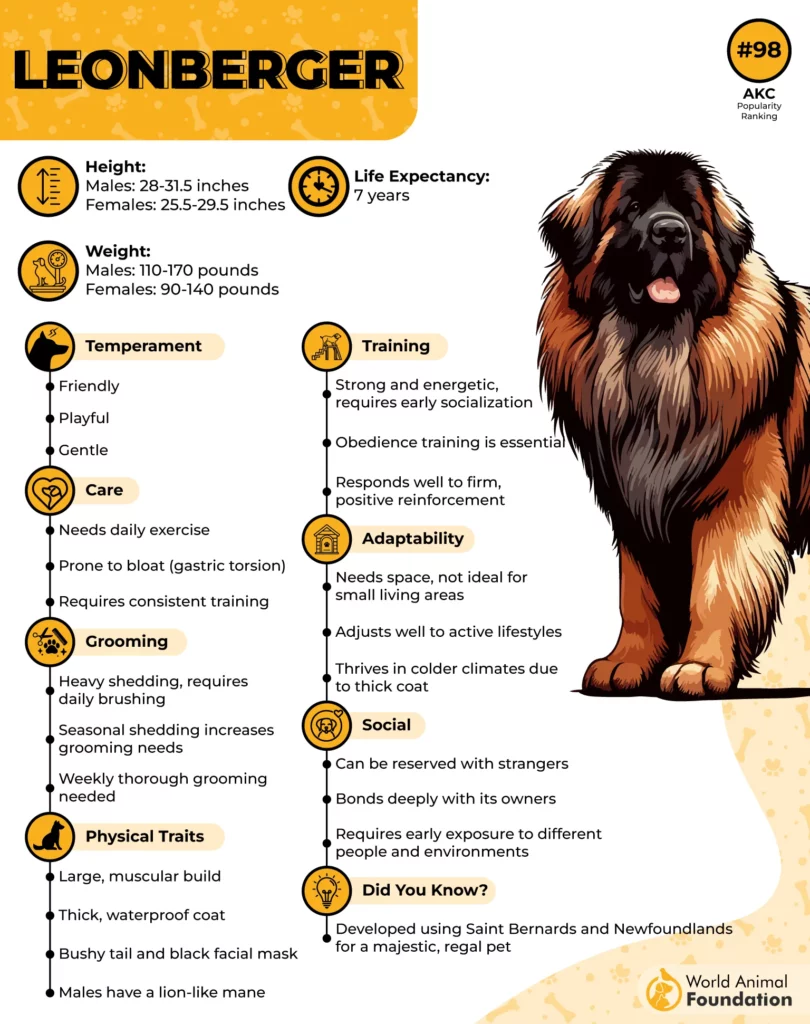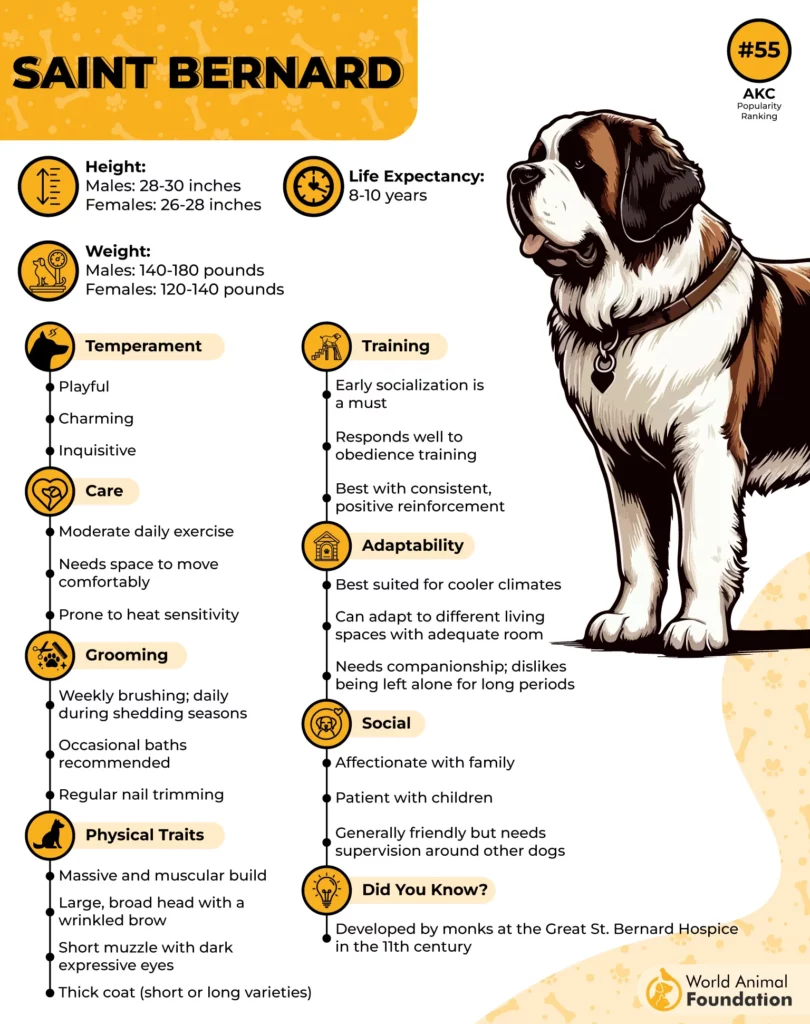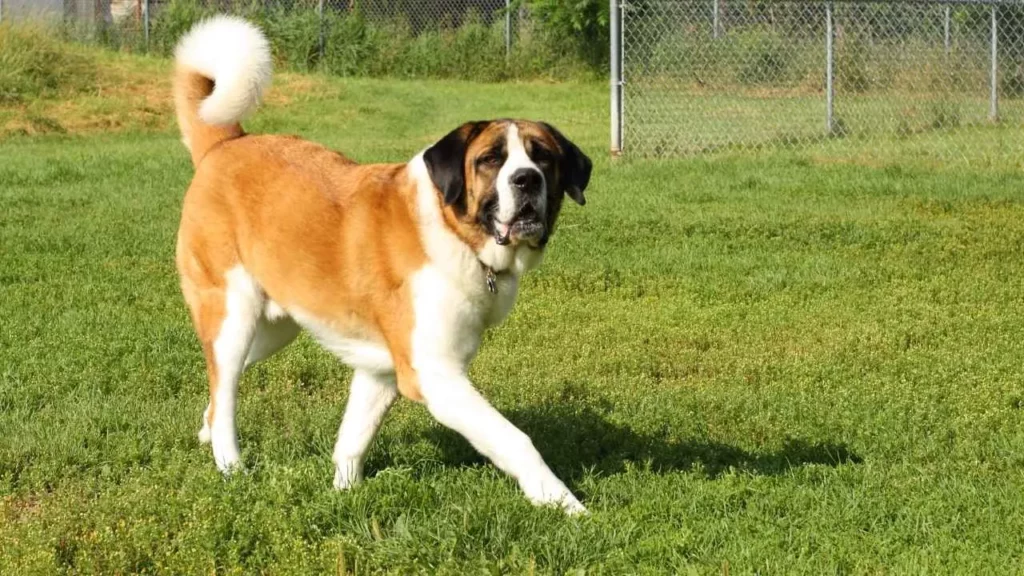You don’t just own a Leonberger or a Saint Bernard. You build your day around them. These aren’t casual pets. They don’t live small, and they don’t ask small things from their humans.
What they give in return, though, is unmatched. Both are famously gentle. Both are full of heart. But what most people don’t realize is how different they are once the leash is off and the front door closes.
One adapts. The other demands. One wants direction. The other offers comfort without a sound. If you’re here, chances are you’re not just looking for a dog. You’re looking for the right companion, the right energy, and the right match for your life’s pace. That answer isn’t always obvious.
But this article? It’ll show you what living with each of these breeds really looks like—so you’re not choosing blindly, but with total confidence.
Leonberger vs. Saint Bernard
Size and Weight: Leonberger vs. St. Bernard
Massive frames with subtle differences
Both breeds fall into the category of truly big dogs, but their builds tell slightly different stories. Leonberger dogs are tall and muscular, standing between 25.5 to 31.5 inches at the shoulder, with males easily reaching up to 170 pounds. St. Bernards are shorter on average, but heavier and bulkier, often tipping the scale beyond 180 pounds.

Built for strength and endurance
Leonbergers were developed for agility and multi-purpose work, so their frames are slightly more athletic despite their size, as mentioned in Purina. St. Bernards, originally bred for rescue in harsh mountain conditions, carry more weight in their chest and shoulders. This difference in build makes Leonberger dogs appear more balanced while still commanding attention.
Height differences you can notice
When standing side by side, the Leonberger tends to have a more towering presence due to its longer legs and straighter back. St. Bernards are stockier, with a broader structure that adds to their heavyweight appearance, as per Britannica. That extra bulk can affect mobility over time, especially in older dogs.

Personality and Temperament: Behavioral Traits Compared
Gentle nature with strong loyalty
Leonberger dogs are known for their calm, steady nature and deep loyalty to their family unit. Their gentle disposition makes them especially well-suited for homes with children. While large in size, they often act as quiet guardians, always alert but rarely reactive.
Social instincts and confidence
Leonberger dogs tend to be naturally social and enjoy spending time around both people and other dogs. Their confident temperament helps them adapt well to new environments without becoming overly dominant. Early socialization supports their balanced, approachable demeanor.

Saint Bernards and their calm presence
Saint Bernards are famously patient and composed, rarely quick to react or show aggression, as highlighted by WebMD. Their interactions with children are often careful and affectionate, making them trusted family companions. They thrive in stable households that appreciate their slower, deliberate ways.
Key contrasts in behavior patterns
While Leonberger dogs tend to be more active and responsive, Saint Bernards prefer a laid-back rhythm and more downtime. Saint Bernards may not mix as easily with many dogs unless raised together, whereas Leonbergers are generally more accommodating.
Activity Level and Playfulness: Which Breed Is More Energetic?
Daily energy needs differ widely
Leonbergers thrive on movement and require regular physical activity to stay balanced. Long walks, hikes, or play sessions help manage their stamina. In contrast, Saint Bernards tend to enjoy slower-paced routines and rest more often throughout the day.

Playfulness with purpose
While both breeds enjoy time with their family, Leonbergers are more likely to initiate play. Their water-loving instincts often come out during outdoor activities. Saint Bernards, on the other hand, prefer short, calm interactions and take longer to warm up to active games.
Exercise and mental stimulation
Leonbergers benefit from consistent mental stimulation alongside exercise, especially when left alone for hours. Puzzle toys and light training sessions keep them content. Saint Bernards can become lazy without structure, so moderate routines help prevent weight gain.
Which lifestyle suits them best
A Leonberger fits best in homes with space and active owners who can match their energy. Saint Bernards adjust more easily to quieter households with a relaxed pace. Their difference in energy shapes their overall compatibility with daily life and the environment.

Adaptability and Independence: How Well Do They Adjust?
Different approaches to routine and change
Leonbergers tend to handle changes in environment or schedule with a bit more ease than Saint Bernards. Their trainability and eagerness to please help them adapt faster. Saint Bernards, on the other hand, are more set in their ways and appreciate consistency.
Comfort in solitude varies
Leonbergers can tolerate brief periods alone if trained early, showing a touch more independence. Saint Bernards are deeply bonded to their families and dislike extended solitude. They may become anxious or restless without human interaction.

Living space preferences
While both are large, Leonbergers adjust better to active homes with some outdoor access, as Hills Pet claims. Saint Bernards prefer a quieter environment and tend to move at a slower pace. Their mellow nature makes them better suited for laid-back households.
Emotional flexibility and family bonding
Leonbergers balance independence with affection, making them flexible in multi-person households. Saint Bernards are more emotionally dependent and crave close, consistent companionship. Their loyalty is deep, but they need steady reassurance from their humans.
Bite Force and Jaw Structure: A Comparative Look
Powerful jaws, but different builds
The Leonberger carries a broad skull and strong muzzle, giving it steady jaw strength without being aggressive by nature. Saint Bernard’s jaws are heavier, built for endurance rather than bite pressure. While both breeds are large, their skull shapes influence their bite mechanics differently.

Not bred for bite but built with force
Neither breed was developed for protection or biting tasks, yet their sheer size gives them naturally high jaw power. Leonbergers have a more balanced head structure, supporting a controlled bite when needed. Saint Bernards lean toward a wider grip, meant more for holding than clamping.
Temperament plays a bigger role
Bite force is rarely an issue due to their calm, predictable nature, especially in well-socialized dogs. Both breeds are known for their patience and gentle responses in family environments. Their size may intimidate, but their behavior rarely matches that impression.

Adjustment depends on space and routine
Both adjust best when given room to move and a predictable schedule. Saint Bernards may need extra time to adapt to smaller homes due to their slower movements. Leonbergers, being slightly more agile, tend to settle into new environments with less effort.
Health Issues and Expected Lifespan
Joint health and orthopedic risks
Leonbergers are known to face orthopedic concerns like elbow and hip issues, especially as they age. Saint Bernards, too, are vulnerable to similar joint stress due to their rapid growth and massive size. Both breeds benefit from early screenings and monitored physical activity.
Lifespan differences worth noting
The Leonberger typically lives around 8–9 years, which is slightly longer than the Saint Bernard’s average of 7–8 years. This gap often comes down to the difference in body structure and inherited health patterns. Proper care can slightly improve these averages, but not drastically.

Other breed-specific concerns
Saint Bernards are more prone to heart conditions and bloat, both of which can escalate quickly if unnoticed. Leonbergers may face certain cancers and neurological disorders in later years. Routine checkups and breed-specific awareness are key for early detection.
Maintenance and prevention strategies
Regular exercise, joint supplements, and weight management help reduce pressure on their frame. Both breeds require a balanced lifestyle tailored to their age and build. Starting preventative habits early can add comfort and possibly extend quality of life.
Feeding Needs and Weight Management Tips
Hearty Appetites, Careful Portions
Both breeds have large appetites, but free feeding isn’t an option here. Their size makes them prone to unnecessary weight gain without structured meals. Measured portions, timed feeding, and calorie tracking help avoid early joint stress.
Nutritional Needs Vary with Age
As puppies, they need high-quality food that supports bone development and slow, even growth. Rapid weight gain in the early stages can create lifelong problems. For adults, protein-rich diets with controlled fat keep energy up without adding bulk.
Monitoring for Bloat and Digestion
According to PetMD, Saint Bernards are especially prone to bloat, requiring slow-feeding bowls and quiet time after meals. Leonbergers, though less affected, still need mealtime supervision. Splitting meals into two or three servings helps digestion in both breeds.

Maintaining Muscle, Not Just Size
Extra weight impacts mobility, so exercise and diet must work hand in hand. Lean muscle maintenance matters more than just hitting weight targets. Regular body checks and vet consultations keep their size in the healthy range.
Grooming Needs and Allergy Considerations
Thick coats with heavy upkeep
Both breeds come with dense, double coats that shed heavily year-round. Regular brushing multiple times a week is a must to control loose fur and avoid matting. Skipping grooming sessions quickly leads to tangles and excess hair around the home.
Seasonal shedding and coat care
Leonbergers tend to shed more in bursts during seasonal changes, while Saint Bernards shed more steadily. Bathing needs are moderate, but drying these thick coats takes time. Investing in grooming tools makes routine care much more manageable.

Not ideal for allergy-sensitive homes
Neither breed is hypoallergenic, and their shedding can trigger symptoms in sensitive individuals. Dander and saliva proteins can linger in the coat and around the house. Regular cleaning helps, but complete allergen control is difficult with these breeds.
Adapting to home life with care
They adjust well to home life when grooming and hygiene are prioritized consistently. Managing shedding, keeping living spaces clean, and brushing outdoors helps a lot. With effort, they can live comfortably even in active family homes.
Conclusion
The Leonberger and Saint Bernard are both stunning, but beauty alone doesn’t make a dog. These giants come from working breed histories, built for rescue work, pulling, and companionship, not just sitting pretty.
If you want a gentle protector with energy, a Leonberger fits the bill. If you’re after a more laid-back, good-natured companion, the Saint Bernard won’t disappoint. Their dense coat, slobber, and size require patience and upkeep, but their loyalty runs deep.
One was shaped by the Swiss Alps, the other was shaped to swim and pull with webbed feet and strength. They aren’t for everyone. But for the right home, they bring unmatched warmth.
Fun fact: both have roots in water rescue, and hearts built to heal.
Whichever dog breed you lean toward, match their spirit with your lifestyle. That’s how you choose a pet.


